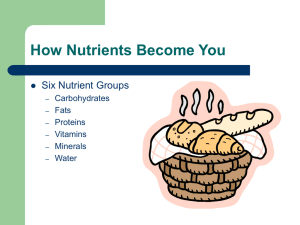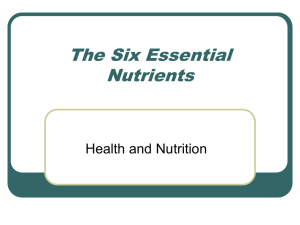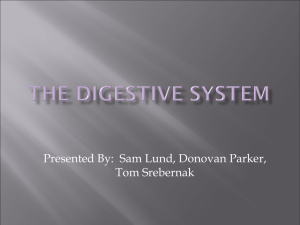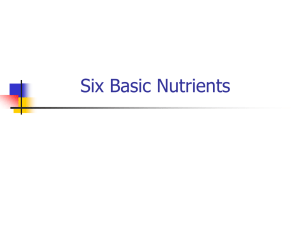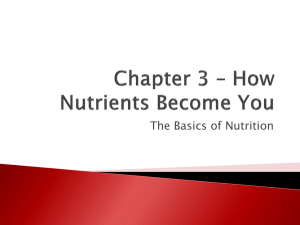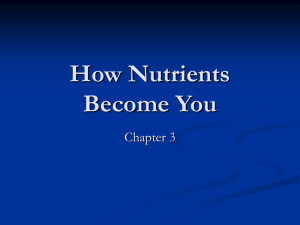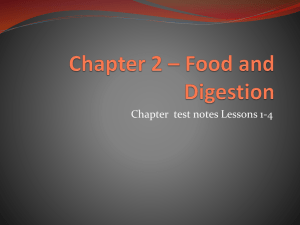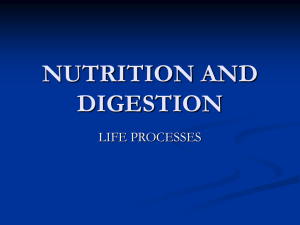Structure and Movement Chapter Test Review
advertisement
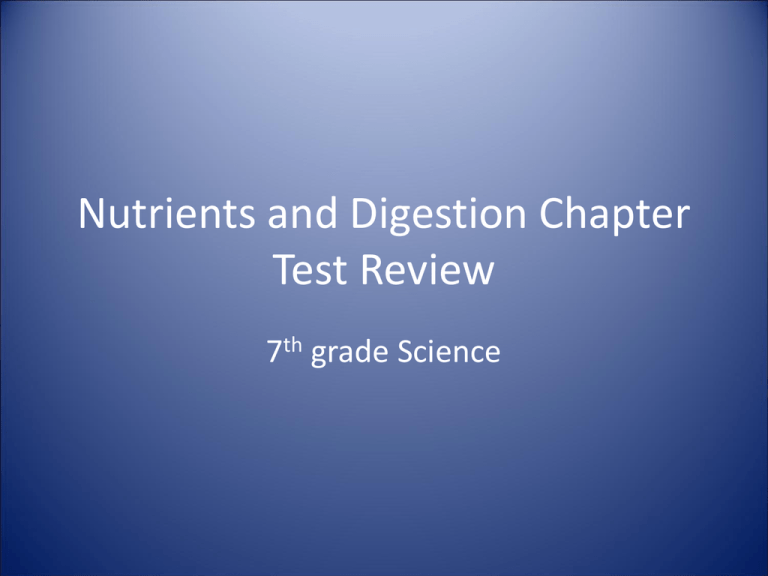
Nutrients and Digestion Chapter Test Review 7th grade Science Main sources of energy; starches and sugars. • Carbohydrates Nutrients that repair and replace body cells. • Proteins Subunits of proteins. • Amino acids Inorganic nutrients that regulate the body’s chemical reactions. • Minerals Physical breakdown of food, as in chewing. • Mechanical Digestion Breakdown of food by enzymes for absorption. • Chemical digestion. Enzyme-containing fluid in the mouth. • Saliva Muscular contractions that move food. • Peristalisis Fingerlike projections in the small intestine. • Villi Unlike inorganic nutrients, organic nutrients contain ________. • carbon Starches are in foods such as potatoes and ________. • grains Milk, cheese, and ______ contain ALL the essential amino acids. • eggs The amount of energy available in foods is measured in ________. • calories ________ are nutrients that help absorb some vitamins. • Fats Saturated fats, found in ______, are believed to contribute to high cholesterol and heart disease. • Red meats _______ are essential, organic nutrients that help your body regulate its functions. • Vitamins Scurvy is a disease caused by a lack of _______ • Vitamin C Trace minerals include copper and _______. • iodine Next to oxygen, _____ is the most vital factor for survival. • water A protein that speeds up the rate of a chemical reaction in your body is called a(n) ________. • enzyme The process of digestion begins in your ______. • mouth Food that leaves your stomach is the form of a thin, watery fluid called ______. • Chyme The major portion of all food ________ takes place in the duodenum. • digestion The major job of the ______ is to absorb water from undigested food. • Large intestine What tells you that eating corn would not add to your cholesterol level? • 0g fat What two nutrients would help build bones and teeth? • Vitamin C and Phosphorus What tells you that eating corn would help give you energy? • 18g carbohydrates Your doctor just told you that you have high cholesterol. What causes high cholesterol, what are its risks, and what can you do to lower your risks? High cholesterol equals saturated fats, this causes deposits in blood vessels, this leads to a chance of heart attack and stroke. To decrease this risk is to eat less fats also known as red meats. If your doctor said you had a Vitamin D deficiency, what changes could you make to correct it? • Spend time in the sun and/or eat foods containing Vitamin D. The main job of the _________ is to absorb water from undigested food. • Large intestine In doing so, the body returns large amounts of water to the body and maintains ________. • Homeostasis _________ slows down somewhat in the large intestine. • Peristasis Chyme may stay here as long as ______ days. • three During this time, excess water is absorbed back into the blood stream. The remaining materials, consisting of __________ and bacteria, become more ________. • Undigested material • solid Bacteria that live here feed on these undigested materials. This is a symbiotic relationship. The bacteria feed on these materials, and in return they produce several _________ that you need. • vitamins List the four organic nutrients and the two inorganic nutrients. • • • • • • • • Organic Carbohydrates Proteins Fats Vitamins Inorganic Minerals Water How do minerals get into your body? • Minerals are absorbed from soil by plants. When you eat plants, you get these nutrients. 8. Place where food is ground mechanically into small pieces 9. Muscular tube that serves as a passageway for food. 10. Turns food into chyme 11. Major portion of all digestion takes place. B. Esophagus F. Mouth H. Small Intestine I. Stomach 12. Produces bile 13. Stores bile 14. Produces substances that stop stomach acid action and enzymes that break down organic nutrients 15. Absorbs water from undigested food 16. Controls the release of solid waste A. Anus C. Gallbladder D. Large intestine E. Liver G. Pancreas Discuss the food pyramid and the relationship between diet and health. The food pyramid helps maintain good health, has the food groups, and calcium-rich foods. What are enzymes and how do they aid in digestion? Enzymes are proteins that help join or break down substances. They are vital in chemical digestion because they help break down food as it passes through the digestive system, without being changed themselves.
